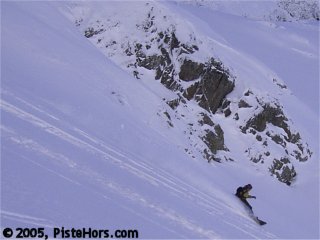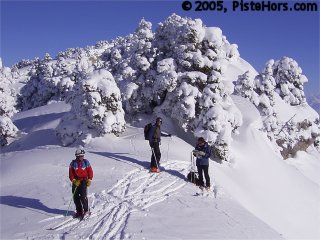
Hard rock pumps out of the tannoy. Every few meters a TV screen shows pictures of riders carving through acres of endless sun drenched powder snow. Looking around the funicular station skiers and snowboarders seem equipped for a walk on the moon rather than a day on the pistes. Helmets, body armour, Iridium coated goggles and backpacks carrying the holy trinity of avalanche beacon, shovel and probe are de-rigueur. They fit the profile[1] of the typical avalanche victim, young and predominantly male.

Off-piste, alone, but for how long?
Outside it is snowing lightly, a cold wind blows from the north. The black and yellow avalanche flag whips about in the breeze like a demented hornet. Initially the skiers explore the fresh powder at the side of the slopes but as this gets tracked out they begin looking further afield. A thick web of netting marked with a “danger avalanche” banner bars the way to a back bowl. Watched by two members of the piste patrol a group of snowboarders struggle over it and onto the virgin slopes beyond. Earlier in the day the pisteurs bombed the slope using a device a bit like a bazooka called an “avalancheur”. It fires an explosive charge up to 1000 meters to secure slopes without risking lives. It is a limited measure, zero risk doesn’t exist in the mountains, but the resort knows that once they open a lift skiers will begin to explore the off-piste.
A heavy tribute was paid to avalanches last week, six deaths in the Savoie region and one in the Pyrénées. The French mountains are seen as a bastion of freedom for backcountry users but the sequence of tragedies has relaunched the debate as to whether there should be more controls on off-piste skiing. In increasingly litigious and risk averse Western societies the freedoms so cherished by off-piste skiers have been under threat for some time. On the 13th of February 1999, following an avalanche in the hamlet of Montroc close to Chamonix the Préfet (state govenor) Pierre Breuil banned all skiing off marked pistes in the department’s ski resorts. The avalanche risk at the time was 5 – generalised risk on all slopes. The ban did not cover those areas outside ski domains that normally used by ski mountaineers. However the scope of the ban enraged guides, ski instructors and off-piste enthusiasts. They lobbied their representatives under the slogan “Non a la montagne interdit!” (No to forbidden mountains). After just a couple of days the Préfet had to back down.
A few days after the lifting of the ban the whole of France was captivated by the search for three missing climbers. The rescue services scoured the Dômes de la Vanoise for four days before finding the trio holed up in a snow cave. The climbers had set out in bad weather and high avalanche risk. Reactions turned to outraged when it transpired that the climbers had sold their story and photographs to Paris Match who then published a 20 page spread. A rescue operation that had risked the lives of the emergency services and cost the public purse many tens of thousands of Euros. The climbers later agreed to contribute some of their money to a fund for orphans of the mountain police.
The 1999 ban has not been repeated although some local mayors have passed bye-laws forbidding off-piste skiing when the avalanche risk is 3 or above. Notably the mayor of Barèges where one of last week’s avalanches occurred. This highlights one of the problems of such bans, without the resources they are difficult to police. During periods of high avalanche risk piste patrollers and police are already hard pressed. Such bans are also fiercely resisted by mountain professionals who believe they are too general in scope. It is hard for a mayor to pass a bye-law when the majority of his voter’s livelyhoods depend on winter sports.

The future - off piste with a professional?
The debate is still open. One Préfet who ran alpine region told PisteHors.com that he believed there should be restrictions on people skiing off-piste without a professional. A law that might please mountain guides and instructors. Other suggestions are for gates that only let skiers equipped with an avalanche beacon access off-piste areas.
Not wishing to kill the goose that lays the golden egg, mountain professionals and the rescue services are more nuanced in their warnings. Last week the commander of the Savoie Mountain Police (PGHM) didn’t say that skiers should not go off-piste, just that they should choose their routes very carefully. Notably, three of last week’s avalanches involved guides and ski instructors and four of the victims were wearing avalanche beacons, a device that enables a skier to be rapidly located under snow.
There are some legal issues surrounding bans. The European Convention on Human Rights protects freedom of movement. There is also the question of what happens when a ban is lifted, does this give a green light to go off-piste and is the State liable for compensation if there is an accident? We put these questions to students at France’s elite Ecole National d’Administration (ENA). The ENA is the training ground for future Prefets, Ministers of State and Judges. They thought that a ban would only be legal if it is limited in time and scope and responds to a specific need. It would also be difficult to find the state liable for accidents subsequent to the lifting of the ban.
It is also important not to over exaggerate the problem. Snowboards and wider skis have led to an explosion in the number of winter sports enthusiasts who venture off-piste but avalanche deaths in recent years has been slightly under the long term average of 31. Professionals are not complacent, there has been a worrying shift in avalanche accidents away from better trained and equipped ski tourers to off-piste skiers, snowboarders and snowshoers. While extolling the freedom offered by their domains ski resorts are trying to do their bit by creating secure off-piste areas and installing avalanche rescue training facilities.
[1]Figures from the ANENA for the last 14 years. 82% of victims are male, 70% of victims, French and 34% are aged 20 to 30 years old.